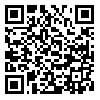Volume 28 - Supplementary
IBJ 2024, 28 - Supplementary: 347-347 |
Back to browse issues page
Download citation:
BibTeX | RIS | EndNote | Medlars | ProCite | Reference Manager | RefWorks
Send citation to:



BibTeX | RIS | EndNote | Medlars | ProCite | Reference Manager | RefWorks
Send citation to:
Rajai Firouzabadi S, Mohammadi I, Aarabi A, Sadraei S, Mofidi S A. Effectiveness of Low-Level Laser Therapy on Treating Allergic Rhinitis: A Systematic Review and Meta-Analysis. IBJ 2024; 28 :347-347
URL: http://ibj.pasteur.ac.ir/article-1-4784-en.html
URL: http://ibj.pasteur.ac.ir/article-1-4784-en.html
Abstract:
Introduction: Allergic rhinitis (AR) is a widespread condition affecting individuals of all ages. Despite not being life-threatening, AR leads to numerous complications, poor asthma control, and reduced quality of life. Current treatments focus on immunomodulation and anti-inflammation, but many patients remain symptomatic even with the most effective pharmacotherapies. Low-level laser therapy (LLLT) is an anti-inflammatory and immunomodulatory treatment that has shown promise for AR in some studies. This systematic review and meta-analysis aimed to evaluate the effects of LLLT in treating AR.
Search Strategy: We conducted a comprehensive search of PubMed, Scopus, and Web of Science on November 24, 2023. The keywords included were related to AR and LLLT. Studies investigating the effects of LLLT on AR were included through a two-step screening process. Two meta-analyses were performed: first, a pre-post meta-analysis compared nasal symptoms (rhinorrhea, nasal congestion, nasal itching, and sneezing) and Rhinoconjunctivitis Quality of Life Questionnaire (RQLQ) scores before and after LLLT. Second, we compared outcomes between LLLT and control groups (placebo, acupuncture, steroids/antihistamines, and ultraviolet lasers). A random-effects model with a conservative pre-post correlation of 0.4 and standardized mean difference (SMD) as the effect size was used.
Results: A total of 16 full-text articles were included. The pre-post meta-analysis revealed a significant reduction in nasal symptoms in 433 AR patients following LLLT (SMD: -1.4; 95% CI: -2.07to -1.13; p = 0.001), though with notable heterogeneity (I²: 67.3%). The meta-analysis of RQLQ scores in 125 patients showed a significant reduction after LLLT (SMD: -0.72; 95% CI: -0.94 to -0.50; p = 0.001) with very low heterogeneity (I²: 0%). Comparisons of LLLT with controls in 618 patients indicated no significant difference between LLLT and placebo (SMD: −0.69; p = 0.167) or LLLT and acupuncture. Additionally, ultraviolet laser was significantly more effective than LLLT in reducing nasal symptoms. Sensitivity analysis confirmed the stability of our results. However, we found significant publication bias in the included studies (p = 0.001).
Conclusion and Discussion: LLLT shows potential as an effective treatment for AR, improving both nasal symptoms and RQLQ scores. Nevertheless, the comparative effectiveness of LLLT versus placebo and other treatments remains uncertain, raising questions about whether observed benefits are due to the placebo or therapeutic effects. Further research is needed to establish the true efficacy of LLLT for AR.

Search Strategy: We conducted a comprehensive search of PubMed, Scopus, and Web of Science on November 24, 2023. The keywords included were related to AR and LLLT. Studies investigating the effects of LLLT on AR were included through a two-step screening process. Two meta-analyses were performed: first, a pre-post meta-analysis compared nasal symptoms (rhinorrhea, nasal congestion, nasal itching, and sneezing) and Rhinoconjunctivitis Quality of Life Questionnaire (RQLQ) scores before and after LLLT. Second, we compared outcomes between LLLT and control groups (placebo, acupuncture, steroids/antihistamines, and ultraviolet lasers). A random-effects model with a conservative pre-post correlation of 0.4 and standardized mean difference (SMD) as the effect size was used.
Results: A total of 16 full-text articles were included. The pre-post meta-analysis revealed a significant reduction in nasal symptoms in 433 AR patients following LLLT (SMD: -1.4; 95% CI: -2.07to -1.13; p = 0.001), though with notable heterogeneity (I²: 67.3%). The meta-analysis of RQLQ scores in 125 patients showed a significant reduction after LLLT (SMD: -0.72; 95% CI: -0.94 to -0.50; p = 0.001) with very low heterogeneity (I²: 0%). Comparisons of LLLT with controls in 618 patients indicated no significant difference between LLLT and placebo (SMD: −0.69; p = 0.167) or LLLT and acupuncture. Additionally, ultraviolet laser was significantly more effective than LLLT in reducing nasal symptoms. Sensitivity analysis confirmed the stability of our results. However, we found significant publication bias in the included studies (p = 0.001).
Conclusion and Discussion: LLLT shows potential as an effective treatment for AR, improving both nasal symptoms and RQLQ scores. Nevertheless, the comparative effectiveness of LLLT versus placebo and other treatments remains uncertain, raising questions about whether observed benefits are due to the placebo or therapeutic effects. Further research is needed to establish the true efficacy of LLLT for AR.

| Rights and permissions | |
 |
This work is licensed under a Creative Commons Attribution-NonCommercial 4.0 International License. |







.png)
